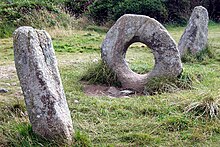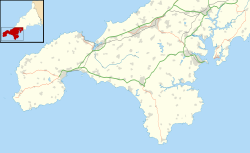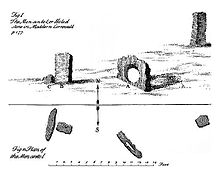49:
56:
469:
375:
766:
367:
29:
426:
358:. If so, then it is likely that the stones have been rearranged at some point, and the two standing stones either side of the holed stone may have been moved from their original positions. It has also been suggested that the holed stone could have been a capstone for the nearby cairn before being moved to its present position.
404:
wrote the first modern archaeological report. He believed that the position of the stones was not the prehistoric arrangement, but had been significantly changed. He also thought that the holed stone might be part of a destroyed tomb. He was even told that local farmers with back or limb complaints
319:
The two side stones are both about 1.2 metres high. The westernmost stone was moved and brought into a straight line with the other two stones sometime after 1815. The holed stone is roughly octagonal in outline. It is 1.3 metres wide and 1.1 metres high; the circular hole is 0.5 m in diameter. The
412:
published a detailed report with the latest research results. They suggested that the standing stones originated from a stone circle which consisted of 18 to 20 stones. The holed stone, however, could be part of a nearby portal tomb. It also possible that the holed stone stood at the center of the
386:, who also drew a plan. This shows that the megaliths were not in a line like today, but formed an angle of about 135°. Borlase also reported that farmers had taken away some stones from the area. From him comes the first written record of the myths and rituals.
455:
a woman passes through the holed stone seven times backwards, she will soon become pregnant. This modern fictional story is attested nowhere in any folklore collections. Another legend is that passage through the stone will cure a child of rickets
445:
baby was put through the stone in order for the mother to get the real child back. Evil piskies had changed her child, and the ancient stones were able to reverse their evil spell.
413:
stone circle and served to frame specific points on the horizon. Such a use of a holed stone is not known in other sites, although the nearby stone circle of
501:
523:
335:
exists as a low stony mound just to the southeast. There are two other early Bronze Age barrows or cairns between 120 and 150 metres to the north.
95:
256:
48:
393:
published several drawings of the site, and made the first suggestion that the stones could be the remains of a stone circle. In 1872
811:
801:
791:
786:
745:
806:
694:
316:
stones: a round stone with its middle holed out with two standing stones to each side, in front of and behind the hole.
658:
528:
354:
The distribution of the stones around the site has led to the suggestion that the monument is actually part of a
476:
Many of the visitors to Mên-an-Tol have their photograph taken placing their heads through the central hole.
252:
460:). For centuries, children with rickets were passed naked through the hole in the middle stone nine times.
488:
756:
351:. The holed stone could originally have been a natural occurrence rather than deliberately sculpted.
394:
401:
344:
331:
There is one other standing stone nearby, and six recumbent stones, some of which are buried. A
285:
737:
8:
201:
Stone setting and holed stone known as the Men-an-Tol, 315m south east of
Coronation Farm
390:
348:
321:
190:
468:
690:
654:
573:
514:
397:, a descendant of the earlier Borlase, gave a more detailed description of the area.
425:
796:
493:
448:
301:
236:
719:
770:
539:
506:
383:
130:
710:
728:
374:
244:
780:
110:
97:
281:
480:
457:
355:
414:
749:
732:
442:
149:
452:
145:
277:
248:
83:
366:
325:
313:
723:
587:
Antiquities
Historical and Monumental of the County of Cornwall
438:
273:
261:
714:
434:
332:
687:
Riddles in Stone: Myths, Archaeology and the
Ancient Britons
534:"Men an Toll" is a piece on the 2022 Cornish language album
382:
In 1749 the site was first archaeologically investigated by
28:
600:
A week at the Land's End, 1861, Churches of West
Cornwall
441:
guardian who can make miraculous cures. In one story, a
640:, Historic Environment Service, Cornwall County Council
320:
only other holed stone in
Cornwall of this type is the
499:
The Men-An-Tol also features prominently in the novel
284:
inscribed stone about 300 metres to the north and the
754:
669:
667:
653:. London: H. Frowde (Reprinted 1981 by Colin Smythe.
512:"Mén-An-Tol" is the name of a level in the 2017 game
343:
The Mên-an-Tol is thought to date to either the late
405:
would crawl through the hole to relieve their pain.
664:
264:. It is also known locally as the "Crick Stone".
778:
280:. Other antiquities in the vicinity include the
483:referred to Mên-an-Tol as "the wind's vagina".
16:Neolithic standing stones in Cornwall, England
569:
567:
565:
563:
561:
559:
557:
555:
689:. London and Rio Grande: Hambledon Press.
27:
521:"Mén-An-Tol" is a song on the 2018 album
429:A view through the Mên-an-Tol holed stone
312:The Mên-an-Tol consists of three upright
272:The Mên-an-Tol stands near the Madron to
552:
467:
424:
389:In the 19th Century the local antiquary
373:
365:
288:less than 1 kilometre to the northeast.
260:). It is about three miles northwest of
779:
684:
673:
625:The Archaeology of Cornwall and Scilly
576:, Pastscape, retrieved 9 November 2013
638:The Men-an-Tol. Management and Survey
486:The song "Men-An-Tol" appears on the
643:
417:does have a central standing stone.
370:Drawing and plan by W. Borlase, 1769
651:The Fairy-Faith in Celtic Countries
324:which can be seen in a garden near
13:
610:William Copeland Borlase, (1872),
463:
55:
14:
823:
704:
433:Mên-an-Tol is supposed to have a
338:
764:
54:
47:
812:Scheduled monuments in Cornwall
802:Tourist attractions in Cornwall
792:Megalithic monuments in England
304:means "the stone of the hole".
63:Shown within Southwest Cornwall
630:
623:Hugh O'Neill Hencken, (1932),
617:
604:
592:
579:
420:
307:
1:
545:
378:Drawing by J. T. Blight, 1864
787:Bronze Age sites in Cornwall
739:Legends of Cornwall's Stones
598:John Thomas Blight, (1864),
589:, Bowyer and Nichols, London
410:Historic Environment Service
291:
7:
807:Stone Age sites in Cornwall
636:Ann Preston-Jones, (1993),
267:
10:
828:
649:Evans-Wentz, W. Y. (1911)
361:
243:) is a small formation of
585:William Borlase, (1769),
225:
221:
213:
205:
197:
188:
184:
176:
168:
160:
155:
141:
136:
126:
89:
79:
71:
42:
38:
26:
685:Hayman, Richard (1997).
395:William Copeland Borlase
111:50.1585597°N 5.6044974°W
472:Men An Tol from the air
733:The Modern Antiquarian
473:
430:
408:In 1993, the Cornwall
379:
371:
286:Boskednan stone circle
116:50.1585597; -5.6044974
724:The Megalithic Portal
471:
428:
377:
369:
72:Alternative name
741:, Gareth Evans, 2005
402:Hugh O'Neill Hencken
107: /
23:
502:The Little Country
474:
451:claims that if at
431:
391:John Thomas Blight
380:
372:
322:Tolvan holed stone
214:Reference no.
209:14th December 1926
191:Scheduled monument
177:Public access
33:Mên-an-Tol in 2006
21:
750:Historic Cornwall
515:Monument Valley 2
479:The Cornish poet
229:
228:
819:
769:
768:
767:
760:
700:
696:978-1-852-855666
677:
671:
662:
647:
641:
634:
628:
621:
615:
612:Naenia Cornubiae
608:
602:
596:
590:
583:
577:
571:
259:
122:
121:
119:
118:
117:
112:
108:
105:
104:
103:
100:
58:
57:
51:
31:
24:
20:
827:
826:
822:
821:
820:
818:
817:
816:
777:
776:
775:
765:
763:
755:
707:
697:
681:
680:
672:
665:
648:
644:
635:
631:
622:
618:
609:
605:
597:
593:
584:
580:
572:
553:
548:
524:The Four Worlds
507:Charles de Lint
466:
464:Popular culture
423:
384:William Borlase
364:
341:
310:
294:
270:
255:
245:standing stones
193:
131:Standing stones
115:
113:
109:
106:
101:
98:
96:
94:
93:
67:
66:
65:
64:
61:
60:
59:
34:
17:
12:
11:
5:
825:
815:
814:
809:
804:
799:
794:
789:
774:
773:
753:
752:
743:
735:
726:
717:
715:Megalithia.com
711:The Mên-an-Tol
706:
705:External links
703:
702:
701:
695:
679:
678:
663:
642:
629:
616:
603:
591:
578:
550:
549:
547:
544:
529:Mark Pritchard
465:
462:
422:
419:
363:
360:
340:
339:Interpretation
337:
309:
306:
293:
290:
269:
266:
253:grid reference
227:
226:
223:
222:
219:
218:
215:
211:
210:
207:
203:
202:
199:
195:
194:
189:
186:
185:
182:
181:
178:
174:
173:
170:
166:
165:
162:
158:
157:
153:
152:
143:
139:
138:
134:
133:
128:
124:
123:
91:
87:
86:
81:
77:
76:
73:
69:
68:
62:
53:
52:
46:
45:
44:
43:
40:
39:
36:
35:
32:
15:
9:
6:
4:
3:
2:
824:
813:
810:
808:
805:
803:
800:
798:
795:
793:
790:
788:
785:
784:
782:
772:
762:
761:
758:
751:
747:
744:
742:
740:
736:
734:
731:site page on
730:
727:
725:
722:site page on
721:
718:
716:
712:
709:
708:
698:
692:
688:
683:
682:
675:
670:
668:
660:
659:0-901072-51-6
656:
652:
646:
639:
633:
626:
620:
613:
607:
601:
595:
588:
582:
575:
570:
568:
566:
564:
562:
560:
558:
556:
551:
543:
541:
537:
532:
530:
526:
525:
519:
517:
516:
510:
508:
504:
503:
497:
495:
492:album by the
491:
490:
484:
482:
477:
470:
461:
459:
454:
450:
446:
444:
440:
436:
427:
418:
416:
411:
406:
403:
398:
396:
392:
387:
385:
376:
368:
359:
357:
352:
350:
346:
336:
334:
329:
327:
323:
317:
315:
305:
303:
299:
289:
287:
283:
279:
275:
265:
263:
258:
254:
250:
246:
242:
238:
234:
224:
220:
216:
212:
208:
204:
200:
198:Official name
196:
192:
187:
183:
179:
175:
171:
167:
163:
159:
154:
151:
147:
144:
140:
135:
132:
129:
125:
120:
92:
88:
85:
82:
78:
74:
70:
50:
41:
37:
30:
25:
19:
738:
686:
676:, p. 4.
650:
645:
637:
632:
624:
619:
611:
606:
599:
594:
586:
581:
535:
533:
522:
520:
513:
511:
500:
498:
487:
485:
481:D. M. Thomas
478:
475:
458:osteomalacia
449:Local legend
447:
432:
409:
407:
399:
388:
381:
356:stone circle
353:
342:
330:
318:
311:
297:
295:
271:
240:
232:
230:
18:
674:Hayman 1997
421:In folklore
415:Boscawen-Un
308:Description
298:Men an Toll
241:Men an Toll
114: /
90:Coordinates
75:Crick Stone
781:Categories
746:Men-an-Tol
729:Men-An-Tol
720:Men-An-Tol
614:, Longmans
574:MEN AN TOL
546:References
443:changeling
349:Bronze Age
282:Mên Scryfa
233:Mên-an-Tol
206:Designated
156:Site notes
150:Bronze Age
99:50°09′31″N
22:Mên-an-Tol
627:, Metheun
494:Levellers
489:Zeitgeist
453:full moon
347:or early
345:Neolithic
296:The name
292:Etymology
169:Ownership
161:Condition
146:Neolithic
102:5°36′16″W
771:Cornwall
661:) p. 179
400:In 1932
278:Cornwall
276:road in
268:Location
257:SW426349
249:Cornwall
84:Cornwall
80:Location
797:Penwith
362:History
326:Helston
314:granite
302:Cornish
237:Cornish
217:1004641
142:Periods
137:History
757:Portal
693:
657:
540:Gwenno
536:Tresor
439:piskie
274:Morvah
262:Madron
251:, UK (
435:fairy
333:cairn
172:CASPN
691:ISBN
655:ISBN
231:The
164:Good
127:Type
748:at
713:at
538:by
527:by
505:by
437:or
300:in
247:in
180:Yes
783::
666:^
554:^
542:.
531:.
518:.
509:.
496:.
328:.
239::
148:/
759::
699:.
456:(
235:(
Text is available under the Creative Commons Attribution-ShareAlike License. Additional terms may apply.



